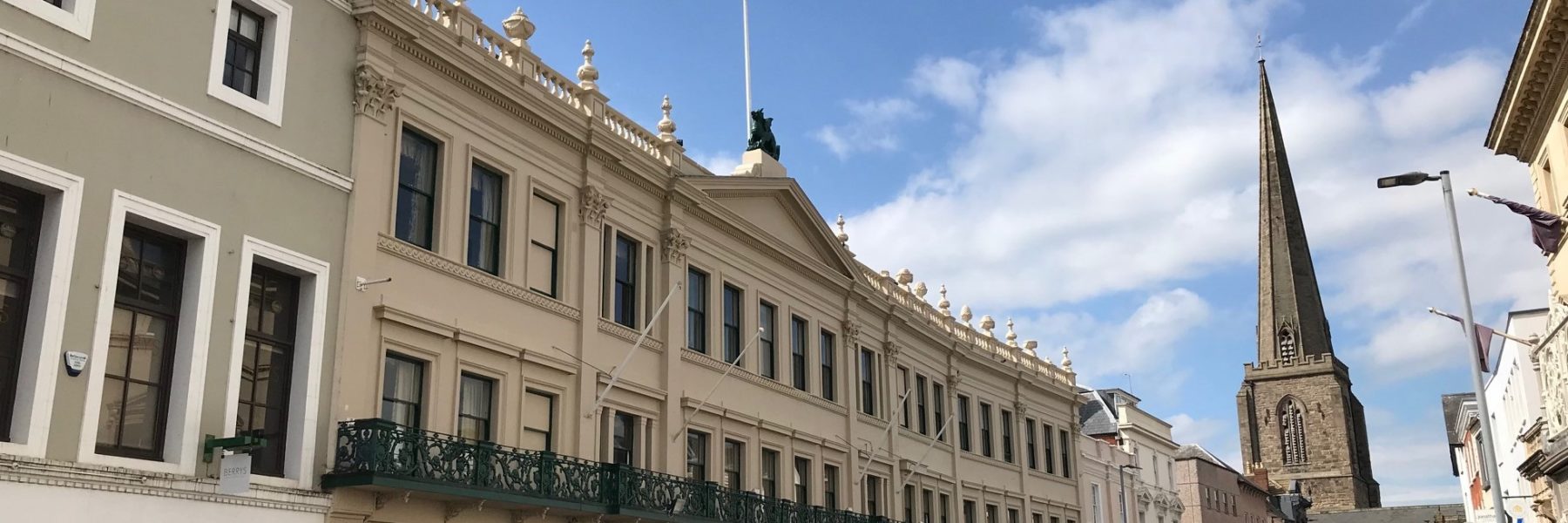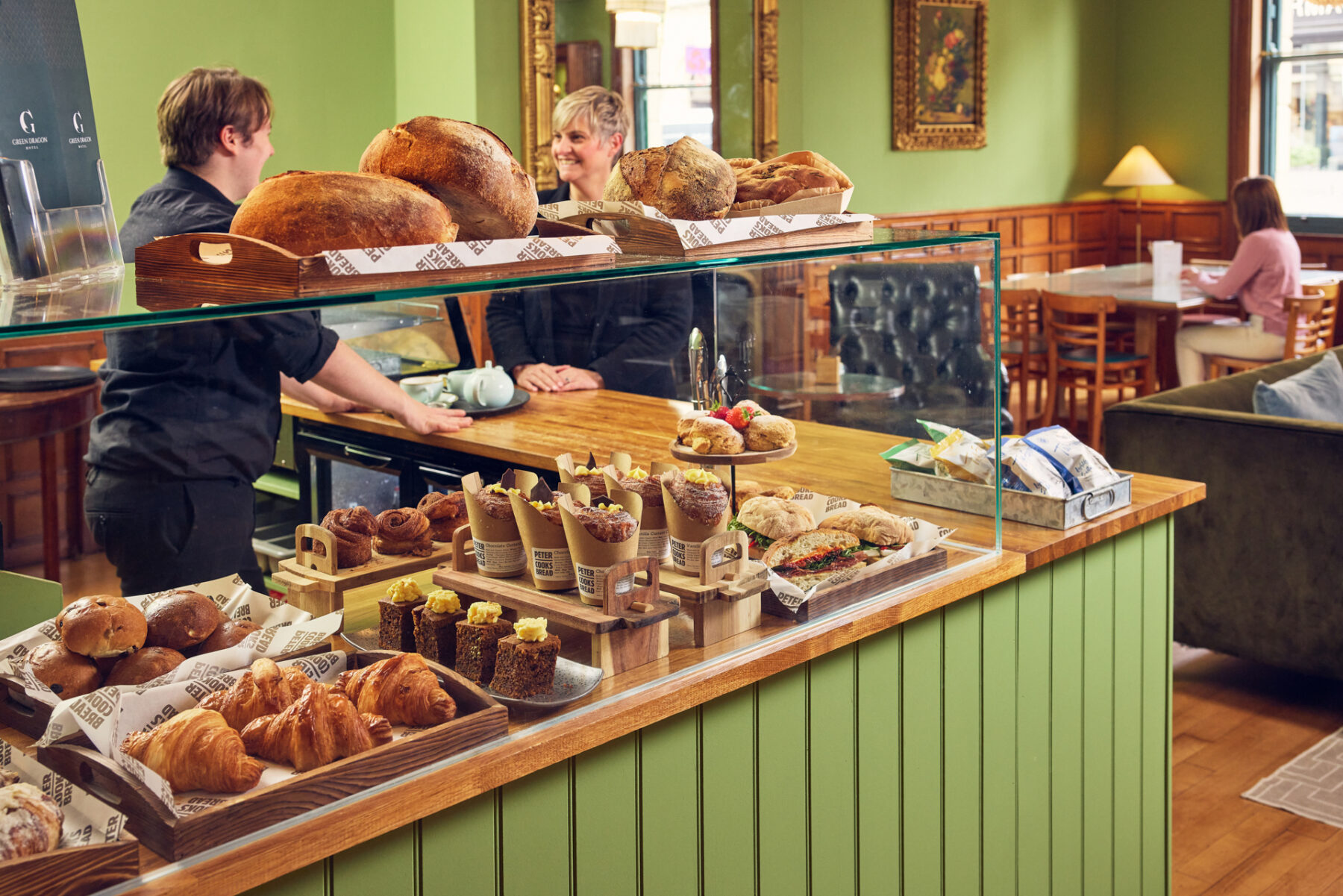A Potted History

One of the Oldest Inns in Britain
The hotel is possibly one of the oldest in Hereford, perhaps even the country with records in the Bishops Palace, sadly lost to fire, rumoured to indicate masons employed in building work on the Cathedral in 1079 were housed at “The White Lion” on the site of the current hotel, this hostelry was owned by the Bishops of Hereford and used as lodging for pilgrims visiting the shrines of St Ethelbert and St Thomas.
Royal Connections
In days gone by Hereford was very much a frontier town in the heart of the Welsh Marches, a strategic stronghold on the hotly contested border with Wales.
After the Battle of Mortimers Cross in 1461 Edward Earl of March (later Edward IV) held Owen Tudor as his prisoner before leading him to his execution in High Town (where a memorial plaque can today be seen marking the spot).
In the 17th century it is rumoured that Prince Rupert, Duke of Cumberland used a secret tunnel from the White Lion Inn to escape or trick Oliver Cromwell’s Parliamentarian forces while engaged in skirmishes in the area. Evidence of the tunnel can still be seen in the cellars today but it is now impassable, but is believed to connect to the Bishops Palace next door to the Cathedral. Historians contest the existence of the tunnels, instead suggesting the likelihood of interconnecting cellars, common in the medieval period.
Firm Facts
The earliest date referring to the original hotel that can be traced in the Cathedral archives is 3rd March, 1644, when The White Lion was taken by Barnabe Smyth for £3, 5s and 2 fat capons (chickens). The lease includes the tenement of The White Lion, and a tenement and barn to the rear.
The Green Dragon
Not much change occurs over subsequent years, until in 27th June 1708, the name on the lease has become The Green Dragon Inn, leased to Mr Thomas Barrow. The hotel has been trading under the name of the Green Dragon ever since! The reason for the name change is lost to historical conjecture, but could well have been an indication of Royal loyalty, as was commonly seen in the names of pubs and inns at the time.
Theatrical Connections
David Garrick, the famous actor and playwright credited with the resurgence of popularity for the works of Shakespeare and friend of Dr Samuel Johnson, was born in Hereford in 1717 and is known to have stayed here.
A Grand Coaching Inn
The 19th Century saw the hotel become the centre of fashionable society life in Herefordshire, with visitors from all over the country attending The Races at Hereford and dances in the grand Assembly Room of the hotel. The rise of stagecoach travel brought visitors from far and wide as the hotel became the predominant Coaching Inn for the area and a major stop of point on the routes from London, Bristol and Carmarthen. Extensive stabling and coaching facilities built to accommodate the carriages and horses can still be seen in the architecture of Aubrey Street to the rear of the main building. The London to Hereford “Mazeppa” stagecoach and the “Champion” were known to have stopped here. The Green Dragon Postal Company operated between 1822 and 1905, the coach can still be seen today in the local museum and would have run to and from the train station, transporting both guests, post, and the visiting magistrates (and occasionally convicts on their way to Australia).
The hotel has altered and changed much over the years, with most of the building as known today reflecting its expansion and inclusion of neighbouring buildings during the Georgian period. The current frontage was built by hotel owners and local entrepreneurs William and John Bosley in 1847, who by this time held the full deeds to the hotel, after they had been purchased from the Vicars Choral by their ancestor, Sarah Eckley. The oldest surviving feature in the hotel, a 15th Century fireplace in the oak panelled Judges Room, is thought to have become part of the hotel during this time.
The 19th Century and Modern Day…
In 1922 under the direction of the former “Green Dragon Hotel Group”, the oak panelling was installed in the dining room in the 16th Century style of the “Bromley by Bow” room at the V&A museum. The Oak was donated by one of the Directors and is said to have come from one enormous tree on Ox Pasture Farm in the village of Marden.
The oldest surviving feature in the hotel, a 15th Century fireplace in the oak panelled Judges Room, is also thought to have become part of the hotel during this time.
The hotel has been the base for many societies and organisations over the years, including the Automobile Association, the prominent Woolhope Society, and the Three Counties Agricultural Society.
It was a routine haunt for famous Herefordshire composer, Sir Edward Elgar, and copies of some of his letters can be seen on display.
With the rise of car ownership, the hotel became a motoring destination, and was said to be one of the finest hotels in all of the West Midlands.
One of the first garages in Hereford was located on Aubrey Street.
The hotel was requisitioned in 1939, four days after the outbreak of WWII by the Allied Forces and supposedly used as a base for American Intelligence services. The cellar was converted into air raid shelters, the metal ceiling plates from this time are still in place today.
It was demobbed in 1946 and returned to regular trade in time for the Three Choirs Festival that year.
In 1953 the Green Dragon was purchased by Trust House Forte, and continued to be a popular and luxurious hotel for many years, with AA star rating. Various owners held custody of the Green Dragon in the subsequent years following the glory days of the 50’s and it has always been a well known and prominent landmark in the life of the city.
In late 2018, the hotel was purchased by a consortium of Herefordshire investors who have exciting plans in store for a £3M refurbishment due for completion in autumn 2019. Mr Julian Vaughan, Managing Director, sees this as a wonderful opportunity to honour the history of the hotel and reinvent its future as a 21st century meeting point for local and international leisure and business communities, and plans to showcase all of the innovative and independent Herefordshire food and drink producers.
To follow the exciting progress of refurbishments and be first to hear as we uncover more of the past, subscribe via the website greendragonhotel.com and follow us on social media @greendragonhfd.
We look forward to seeing you soon.
Julian Vaughan shares our vision for the future of the Green Dragon Hotel
Our vision for the future of the Green Dragon Hotel has very much been inspired by its impressive heritage as a key part of life in the city for residents and visitors alike, for many hundreds of years. The aim of the refurbishment was to breathe life back into both the accommodation and community life here at the hotel, with well priced, boutique style rooms and a showcase of local food and drink in our restaurants. We hope the investment and revitalisation we have brought to the hotel will inspire many generations to come to cherish this incredible building, and we hope to see Herefordshire become the tourist destination it deserves to be with more visitors discovering the hidden treasures we have on offer.
